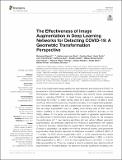| dc.contributor.author | Elgendi, Mohamed | |
| dc.contributor.author | Nasir, Muhammad Umer | |
| dc.contributor.author | Tang, Qunfeng | |
| dc.contributor.author | Smith, David | |
| dc.contributor.author | Grenier, John-Paul | |
| dc.contributor.author | Batte, Catherine | |
| dc.contributor.author | Spieler, Bradley | |
| dc.contributor.author | Leslie, William Donald | |
| dc.contributor.author | Menon, Carlo | |
| dc.contributor.author | Fletcher, Richard R | |
| dc.contributor.author | Howard, Newton | |
| dc.contributor.author | Ward, Rabab | |
| dc.contributor.author | Parker, William | |
| dc.contributor.author | Nicolaou, Savvas | |
| dc.date.accessioned | 2021-03-22T22:39:31Z | |
| dc.date.available | 2021-03-22T22:39:31Z | |
| dc.date.issued | 2021-03 | |
| dc.date.submitted | 2020-09 | |
| dc.identifier.issn | 2296-858X | |
| dc.identifier.uri | https://hdl.handle.net/1721.1/130233 | |
| dc.description.abstract | Chest X-ray imaging technology used for the early detection and screening of COVID-19 pneumonia is both accessible worldwide and affordable compared to other non-invasive technologies. Additionally, deep learning methods have recently shown remarkable results in detecting COVID-19 on chest X-rays, making it a promising screening technology for COVID-19. Deep learning relies on a large amount of data to avoid overfitting. While overfitting can result in perfect modeling on the original training dataset, on a new testing dataset it can fail to achieve high accuracy. In the image processing field, an image augmentation step (i.e., adding more training data) is often used to reduce overfitting on the training dataset, and improve prediction accuracy on the testing dataset. In this paper, we examined the impact of geometric augmentations as implemented in several recent publications for detecting COVID-19. We compared the performance of 17 deep learning algorithms with and without different geometric augmentations. We empirically examined the influence of augmentation with respect to detection accuracy, dataset diversity, augmentation methodology, and network size. Contrary to expectation, our results show that the removal of recently used geometrical augmentation steps actually improved the Matthews correlation coefficient (MCC) of 17 models. The MCC without augmentation (MCC = 0.51) outperformed four recent geometrical augmentations (MCC = 0.47 for Data Augmentation 1, MCC = 0.44 for Data Augmentation 2, MCC = 0.48 for Data Augmentation 3, and MCC = 0.49 for Data Augmentation 4). When we retrained a recently published deep learning without augmentation on the same dataset, the detection accuracy significantly increased, with a χ[superscript 2]McNemar's statistic = 163.2 and a p-value of 2.23 × 10[superscript −37. This is an interesting finding that may improve current deep learning algorithms using geometrical augmentations for detecting COVID-19. We also provide clinical perspectives on geometric augmentation to consider regarding the development of a robust COVID-19 X-ray-based detector. | en_US |
| dc.description.sponsorship | NSERC (Grant RGPIN-2014-04462) | en_US |
| dc.publisher | Frontiers Media SA | en_US |
| dc.relation.isversionof | https://doi.org/10.3389/fmed.2021.629134 | en_US |
| dc.rights | Creative Commons Attribution 4.0 International license | en_US |
| dc.rights.uri | https://creativecommons.org/licenses/by/4.0/ | en_US |
| dc.source | Frontiers | en_US |
| dc.title | The Effectiveness of Image Augmentation in Deep Learning Networks for Detecting COVID-19: A Geometric Transformation Perspective | en_US |
| dc.type | Article | en_US |
| dc.identifier.citation | Elgendi, Mohamed et al. "The Effectiveness of Image Augmentation in Deep Learning Networks for Detecting COVID-19: A Geometric Transformation Perspective." Frontiers in Medicine 8 (March 2021): 629134. © 2021 Elgendi et al. | en_US |
| dc.contributor.department | Massachusetts Institute of Technology. Department of Urban Studies and Planning | en_US |
| dc.contributor.department | Massachusetts Institute of Technology. Device Research Laboratory | en_US |
| dc.contributor.department | Massachusetts Institute of Technology. Department of Mechanical Engineering | en_US |
| dc.relation.journal | Frontiers in Medicine | en_US |
| dc.eprint.version | Final published version | en_US |
| dc.type.uri | http://purl.org/eprint/type/JournalArticle | en_US |
| eprint.status | http://purl.org/eprint/status/PeerReviewed | en_US |
| dspace.date.submission | 2021-03-22T14:27:27Z | |
| mit.journal.volume | 8 | en_US |
| mit.license | PUBLISHER_CC | |
| mit.metadata.status | Complete | |
